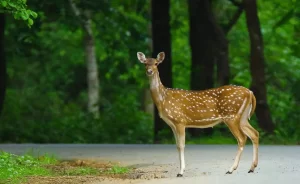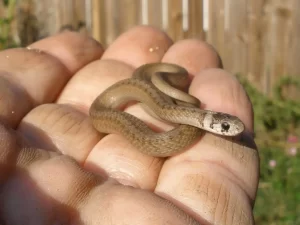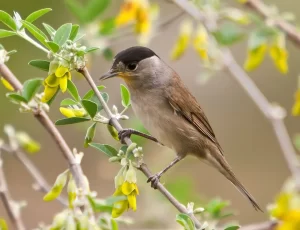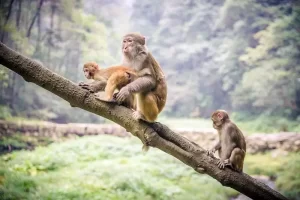The Axis deer is a beautiful mammal with a spotted body and short tail. Both males and females have markings on their bodies; the markings are white, running in rows along the length of their bodies. The body of Axis deer is bright golden brown in color while the head is a bit lighter shade of the same color. Around their eyes, they have stripes of fur that are paler in color.

Axis deer
Males have black spots on their faces and three tines on each of their magnificent antlers. These deer have a dark stripe, running along the length of their back and bordered by a row of spots. The outer parts of their legs are light brown in color while the underparts can be both white and creamy. The Axis deer has a white spot on its throat, which is more noticeable in males. In addition, the tail of the Axis deer has a white underpart. For more information about this beautiful mammal, read the full article with Pritish Kumar Halder.
Distribution
Most of the Axis deer population is concentrated in the forests of India. The major area of their distribution is Sri Lanka and India,

Range of Axis deer
though they are introduced to USA and Australia as well. They live in dense forests, forested valleys and also prefer open grasslands, savannas, and plantations.
Description
The chital is a moderately sized deer. Males reach nearly 90 cm (35 in) and females 70 cm (28 in) at the shoulder; the head-and-body length is around 1.7 m (5 ft 7 in). While immature males weigh 30–75 kg (66–165 lb), the lighter females weigh 25–45 kg (55–99 lb). Mature males can weigh up to 98 to 110 kg (216 to 243 lb). The tail, 20 cm (7.9 in) long, is marked by a dark stripe that stretches along its length. The species is sexually dimorphic; males are larger than females, and antlers are present only on males.
The dorsal (upper) parts are golden to rufous, completely covered in white spots. The abdomen, rump, throat, insides of legs, ears, and tail are all white. A conspicuous black stripe runs along the spine (back bone). The chital has well-developed preorbital glands (near the eyes) with stiff hairs. It also has well-developed metatarsal glands and pedal glands located in its hind legs. The preorbital glands, larger in males than in females, are frequently opened in response to certain stimuli.

Axis deer – Description
Each of the antlers has three lines on it. The brow tine (the first division in the antler) is roughly perpendicular to the beam (the central stalk of the antler). The antlers, three-pronged, are nearly 1 m (3 ft 3 in) long. Antlers, as in most other cervids, are shed annually.
The antlers emerge as soft tissues (known as velvet antlers) and progressively harden into bony structures (known as hard antlers), following mineralisation and blockage of blood vessels in the tissue, from the tip to the base. A study of the mineral composition of the antlers of captive barasinga, chital, and hog deer showed that the antlers of the deer are very similar. The mineral content of the chital’s antlers was determined to be (per kg) 6.1 mg (0.094 gr) copper, 8.04 mg (0.1241 gr) cobalt, and 32.14 mg (0.4960 gr) zinc.
Habits and Lifestyle
Axis deer are highly sociable animals. Their herds can contain 6-30 individuals, two or three of them being stags. Adult females with their fawns from the present and previous year usually form matriarchal herds. On the other hand, males live in a hierarchical system with larger and older males dominating smaller and younger ones. The Axis deer are always on the alert, in anticipation of a sudden appearance of a predator. The period of these animals’ highest activity is morning and late afternoon.

Axis deer Habits
At the heat of the day the Axis deer usually rest under the shadow. When the weather is hot, they tend to remain near water, drinking in the mornings and evenings. Axis deer are vocal animals and give out bellows and alarm barks. Males may moan during aggressive displays or while resting. Mainly females and juveniles bark persistently when alarmed or if they encounter a predator. Fawns in search of their mother often squeal.
Diet and Nutrition
Axis deer are herbivores (graminivores, folivores). Their diet usually consists of grasses, flowers, and fruits, fallen from the trees.

Axis deer diet
When the monsoon season comes, grasses and sedges become the main source of food for these animals. They also prefer mushrooms that are rich in proteins and nutrients. In addition, the Axis deer can browse when needed.
Mating Habits
Axis deer are polygynous: a male can mate with more than one female. When mating season comes, males start bellowing, indicating the beginning of breeding. Breeding takes place in April or May while the gestation period lasts 210-225 days.

Axis deer baby
These animals produce young every year with females giving birth to 1 or 2 fawns at once. During the first 2 weeks after birth, the young live in hiding spots, where they are visited by their mother. The mother nurses its babies until they are 6 months old. They become reproductively mature at the age of 12-14 months.
Population
Population threats
One of the major threats to the Axis deer population is natural predators such as leopards and wild dogs. On the other hand, deforestation and subsequent loss of habitat also lead to the decline of the population.

Population number
According to IUCN, the Axis deer is widespread throughout its range but no overall population estimate is available. However, in the IUCN Red List, the Axis deer is classified as Least Concern (LC).
Ecological niche
These animals are important consumers in the ecosystem of their habitat. Moreover, due to being herbivores, they can even be considered primary consumers. On the other hand, they themselves become food for predators of the area. Since the Axis deer feed upon plants, in some forests, green plants are held in check by these animals. Without the deer in the ecosystem, some plants might overpopulate while the population of certain animal species, which mainly feed on the deer, would decrease without a key source of food.
Fun Facts for Kids
- The Axis deer often graze near trees where langurs live. One of the reasons they do it is that sometimes langurs drop fruits that the Axis deer feed on. Another reason is that due to their higher position, langurs can warn the deer of approaching predators.
- Teeth of the Axis deer are perfectly designed for grazing.
- They also lick and eat their shed antlers that contain nutrients.
- When grazing together, these animals are usually silent. Males try to reach tall branches of trees, standing on their hind legs.
- Axis deer can respond to the alarm calls of several animals, such as the Common myna and langurs.
Reference










